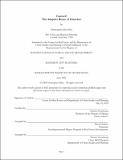| dc.contributor.advisor | Dennis Frenchman. | en_US |
| dc.contributor.author | Kiley, Christopher John, 1972- | en_US |
| dc.contributor.other | Massachusetts Institute of Technology. Dept. of Urban Studies and Planning. | en_US |
| dc.date.accessioned | 2007-01-10T19:39:20Z | |
| dc.date.available | 2007-01-10T19:39:20Z | |
| dc.date.copyright | 2004 | en_US |
| dc.date.issued | 2004 | en_US |
| dc.identifier.uri | http://hdl.handle.net/1721.1/35692 | |
| dc.description | Thesis (M.C.P. and S.M. in Real Estate Development)--Massachusetts Institute of Technology, Dept. of Urban Studies and Planning, 2004. | en_US |
| dc.description | This electronic version was submitted by the student author. The certified thesis is available in the Institute Archives and Special Collections. | en_US |
| dc.description | Page 160 blank. | en_US |
| dc.description | Includes bibliographical references (p. 155-159). | en_US |
| dc.description.abstract | This thesis examines the phenomenon of vacated churches and analyzes the major issues underlying their adaptive reuse in order to help promulgate an awareness of the range of successful strategies and solutions that are available to stakeholders who are interested in seeing a former church building preserved through its conversion to a new use. The reuse potential of a church is affected by the building typology and its structural condition, the stakeholders involved, the process used, the regulatory context, finance and site issues. Reuse potential for a church can also be informed by researching and documenting examples of previously successful reuse strategies. These issues are examined closely in this thesis, as is a case study of a successful public-private church redevelopment project in Brookline, MA. The results of the research and analysis are used to form a series of findings and recommendations regarding the reuse of churches. The recommendations include combining funding sources, engaging the congregation and the public, retaining the appropriate kind of developer for the end goal, undertaking public-private redevelopment processes and the importance of identifying interim solutions. The recommendations are tested for credibility by applying them to a real situation in Plymouth, MA while working with a team of developers to asses the reuse potential of a historic church for a downsizing congregation. | en_US |
| dc.description.statementofresponsibility | by Christopher John Kiley. | en_US |
| dc.format.extent | 160 p. | en_US |
| dc.format.extent | 6008103 bytes | |
| dc.format.extent | 6277926 bytes | |
| dc.format.mimetype | application/pdf | |
| dc.format.mimetype | application/pdf | |
| dc.language.iso | eng | en_US |
| dc.publisher | Massachusetts Institute of Technology | en_US |
| dc.rights | M.I.T. theses are protected by copyright. They may be viewed from this source for any purpose, but reproduction or distribution in any format is prohibited without written permission. See provided URL for inquiries about permission. | en_US |
| dc.rights.uri | http://dspace.mit.edu/handle/1721.1/7582 | |
| dc.subject | Urban Studies and Planning. | en_US |
| dc.title | Convert! : the adaptive reuse of churches | en_US |
| dc.title.alternative | Adaptive reuse of churches | en_US |
| dc.type | Thesis | en_US |
| dc.description.degree | M.C.P.and S.M.in Real Estate Development | en_US |
| dc.contributor.department | Massachusetts Institute of Technology. Department of Urban Studies and Planning | |
| dc.identifier.oclc | 56409883 | en_US |
